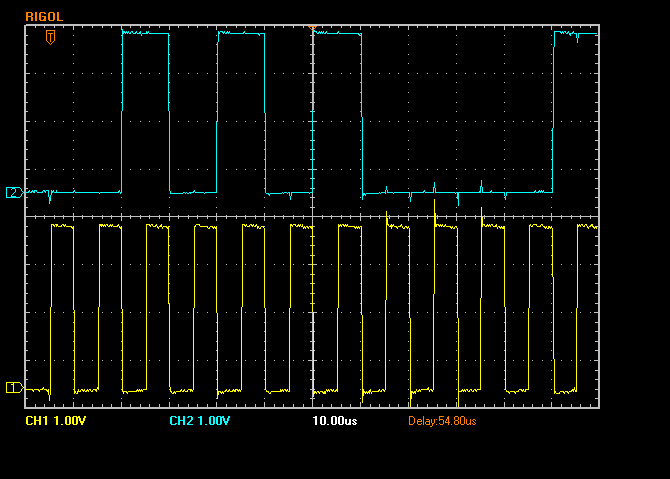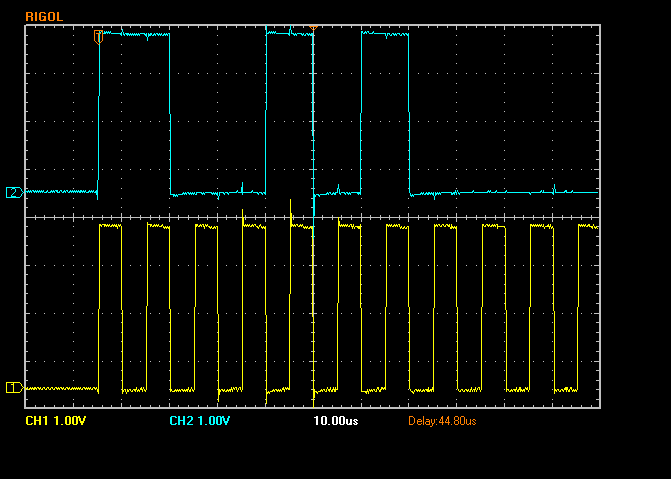SPI Pins for the Omega2
-
@Brice-Parent What did you install to make it work on the omega2?
I followed the documentation but I get an error while registering the spi device : "Failed to find spi-gpio-custom. Maybe it is a built in module ?"
-
@Pierre-Rossinès said in SPI Pins for the Omega2:
@Brice-Parent What did you install to make it work on the omega2?
I followed the documentation but I get an error while registering the spi device : "Failed to find spi-gpio-custom. Maybe it is a built in module ?"spi-gpio-custom is software-based bit-banged SPI. The hardware-SPI on GPIOs 6-9 should already be enabled by default. Just do
ls -l /dev/spi*and the SPI-bus should show up.
-
@WereCatf It does show up, but when I use it with the python library as described here : https://docs.onion.io/omega2-docs/spi-python-module.html
I get that error.My code is pretty simple :
import onionSpi spi = onionSpi.OnionSpi(32766, 1) spi.sck = 7 spi.mosi = 8 spi.miso = 9 spi.cs = 6 spi.registerDevice() spi.setupDevice()I got the 32766, 1 part from the /dev/spi32766.1 file name
-
@WereCatf Thanks. But how do I do that? I see no equivalent of what I've found in other implementations (opening the communication, sending multiple writes, closing the com). I tried :
pixels = [] for i in range(16): pixels.append(0xFF) spi.write(pixels) spi.write(pixels)but it will write those 16 values twice, not add the second call at the end of the first.
Also,
spi.writeBytesonly inserts the value of [address] at the beginning of the list of values, so it does not address the problem. The two follogins statements are equivalent :spi.write([0x66, 0x00, 0xFF]) spi.writeBytes(0x66, [0x00, 0xFF])@Pierre-Rossinès What works for me, even if it only partially works, is the following :
import onionSpi spi = onionSpi.OnionSpi(1, 32766) spi.speed = 1000000 spi.mode = 0 spi.lsbfirst = False spi.checkDevice() spi.registerDevice() spi.setupDevice() spi.write([0] * 16)I'm not sure I need every single line though.
-
@Pierre-Rossinès Also, I don't remember what I've installed, but in my installed packages, I have (I only put the ones that seemed relevant to me) :
fast-gpio - 0.1-1 gpioctl-sysfs - 0.0.6-1 libonionspi - 0.1-1 pyOnionSpi - 0.1-1 python-base - 2.7.13-3 python-light - 2.7.13-3 spi-tool - 0.1-1 spi-tools - 1-cc6a41fdcec60610703ba6db488c621c64952898I don't remember having manually installed anything other that pyOnionSpi and maybe python-light (and I'm not even sure for those two...), and I particularly don't remember having installed a specific version of spi-tools like I see here... But anyway, that"s what makes it partially work here !
Edit : But it looks like you just reversed the arguments when creating the OnionSpi object (use
1, 32766instead of32766, 1).
-
@Brice-Parent
Indeed, my only mistake was to swap the arguments.
I did not have the spi-tools package installed but I'm not sure it is really necessary.My code seems to work now.
Thank you very much !
-
@Pierre-Rossinès Have you been able to write more than 16 bytes? (if you needed to of course)
-
@Brice-Parent I don't need it, I'm using the SPI to communicate with a very simple MCP3008
-
I would like to report two issues with using SPI in Python on the Omega2. The first is that the transmit and receive buffers are only 16 bytes. There should be a mechanism in the driver that allows for DMA or interrupts to allow the use of a list longer than 16 bytes. The reason I say this is that the best time between SPI bursts is about 150uS. In other words, the following code;
spi.write([[0xAA, 0x55, 0xAA])
spi.write([[0xAA, 0x55, 0xAA])will result in about 150uS between SPI transmissions. If the SPI driver would recognize that the list passed in is longer than the built-in queues and then use an interrupt or DMA to keep the queue full until the list was exhausted then a list with several hundred bytes could be sent as one continuous transmission. This would facilitate using the SPI device to drive strings of NeoPixels. As it stands now, only a string of one NeoPixel can be driven by the SPI device. This would also help in using the SPI to communicate with an SPI based tft LCD or any device that requires more than 16 bytes in a continuous burst.
The second issue is that the first byte transmitted always sets the most significant bit to zero (when MSB first). So sending 0xAA results in 0x2A being sent. Not good. This only happens to the first byte of each burst. The only thing I changed from default was the bitrate.
Finally, a complaint that seems to be echoed everywhere in the world of the Omega2. That is the lack of documentation. What is available has mistakes, references the Omega or leaves a lot of information out.
-
@James-Behrens I've open a ticket 12 days ago about that, without the 150uS delay that I didn't know about (I don't have a scope), but so far no answer from the team. I'll link it to your post for more info.
Also, if you find a workaround to be able to use more than 16 bytes without having to wait for a software update, like a software SPI or another library, please tell me about it.
-
Have a look at this defect:
https://dev.openwrt.org/ticket/20521
That's surely the root cause of this issue in Omega2; it's in the upstream source and may represent a hardware limitation of the MT7688/7621 SoC.
-
... and the more I look at this, I think this may not be a bug. The MT7688 hardware can handle only so many bytes per hardware transfer, but it looks like the Linux SPI permits a transfer to be broken into an array of transfers that are processed with a single Chip Select - chaining them together. So it may be some additional work is required in the C and Python libs.
-
So - about the leading bit of 'address' (which is not a pure SPI construct - there's no requirement for an address to be the first byte of a transfer, or even for transfers to be in bytes). On a hunch, I tried values of address with the top two bits being '10' (example, 0xaa, 0xb2, 0x88, etc.) and values of address with the top two bits being '11' (ex. 0xc0, 0xff, etc.) and found that anything with '10' in the top two bits loses the MSB (transfers it as '0') and anything with '11' in the top two bits transfers it correctly. My test hardware SPI slave is an Atmel ATmega1284P , with the clock phase/polarity set to 0 (which matches the default settings in the Linux driver) (any other settings in the AVR SPI slave corrupt the data). I tried reducing the clock rate and adding a delay but never helped.
So I'm guessing there's a timing/phase issue there; I'll have to get the oscilloscope out and have a look.
-
@James-Behrens as you probably have seen in my messages; the Omega Python library needs to break up the SPI transfer into 16-byte chunks and chain them together in the SPI_IOC_MESSAGE() call - I think that'll solve the transfer limitation. The loss of the MSB in the first byte (aka address) happens when the top two bits are '10' and not when they're '11' and that's apparently something in the MT7688 SPI driver and/or timing of the SPI slave.
-
So here's a capture of CLK and MOSI from "spi-tool write 0xaa 0x11":

Upper trace is MOSI, lower trace is CLK, aligned to the vertical grid (10uS). You see the CLK leading-edge transitions are in the middle of the data - it all looks right except the first '1' bit is missing (far left, the first clock transition occurs while MOSI is 0).
This is "spi-tool write 0xca 0x11":

So here, MOSI starts with an abbreviated '1' bit, only about 1/2 as long as it should be, though the rest of the data timing is correct.
There are two problems:
- list itemWhen the first two bits are '10', the leading '1' is completely not sent by the SPI peripheral.
- list itemWhen the first two bits are '11', the leading '1' is about half as long as it should be.
This makes me think something is amiss with the SPI peripheral - perhaps some timing in the MT7621 SPI driver?
-
Oh - a known bug in the MT7688:
-
I noticed this bug myself, too, though I wasn't entirely sure, if it was something I did wrong with my custom images. Then I got distracted with other things in life and forgot to investigate this further. Anyways, if someone wishes to test, I compiled custom images for Omega2 and Omega2+, that include a patch for the SPI-stuff -- both images and a good bunch of various kernel-modules can be found inside https://dl.dropboxusercontent.com/u/11811685/omega2-stuff/omega2-spi-test.tar.bz2
I don't have many SPI-devices to test with, nor do I have a logic-analyzer to look at the output with, and besides, I'm quite occupied with other stuff at the moment, so I can't test how/if SPI works any better now. If someone here does get around to testing the images, I would appreciate hearing about the results. My images work similar to the official ones, ie. it sets up an AP on first boot and such, and you can use a web-interface to configure it. Don't forget to flash with
sysupgrade -n /tmp/image.bin-- has to be in /tmp and you should use the "-n" flag.EDIT: I forgot to mention that I included various SPI-related tools in the image, so there's no need to install them from the repos.
-
@WereCatf Which patch did you use? I'm integrating and unit-testing the patch I found in the Mediatek Labs forum; same one?
-
@Dana-Myers114 Aye, that one, yes.
-
@WereCatf @WereCatf I'm fixin' to test that patch myself; any hints on generating the LEDE build? I'm rather hoping I can
a) Add the onion feed to feeds.conf.default with this line:
src-git onion https://github.com/OnionIoT/OpenWRT-Packages.git;omega2b) start with .config :
CONFIG_TARGET_ramips=y
CONFIG_TARGET_ramips_mt7688=y
CONFIG_TARGET_ramips_mt7688_DEVICE_omega2=yfollowed by make defconfig
After that, make menuconfig and select spi-tool + Python lib, then sysupgrade my test target. Is there any reason '-n' is required in the sysupgrade? I have a serial console anyway but I figure a regular sysupgrade ought to work OK if I make sure to include the Mediatek SoftAP driver from the onion feed.
Once I establish the baseline build works, I'll drop in the patched spi-mt7621.c source and
spin it.Any hints?